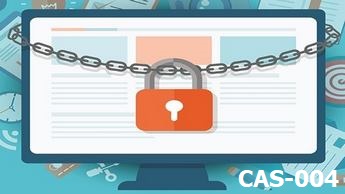Use VCE Exam Simulator to open VCE files

CompTIA SY0-601 Practice Test Questions, CompTIA SY0-601 Exam Dumps
With Examsnap's complete exam preparation package covering the CompTIA SY0-601 Practice Test Questions and answers, study guide, and video training course are included in the premium bundle. CompTIA SY0-601 Exam Dumps and Practice Test Questions come in the VCE format to provide you with an exam testing environment and boosts your confidence Read More.
The modern IT environment is increasingly complex, and organizations are facing an escalating number of cyber threats. As a result, the demand for qualified cybersecurity professionals has never been higher. Among the certifications that validate essential cybersecurity knowledge and skills, CompTIA Security+ SY0-601 stands out as one of the most recognized credentials. It provides a comprehensive foundation for IT professionals looking to secure networks, protect data, and respond to cybersecurity incidents effectively. We explore the essentials of Security+ SY0-601, including its scope, structure, and relevance in the cybersecurity industry.
Cybersecurity is no longer a niche field; it has become a critical requirement across all industries. Organizations must protect sensitive information, ensure regulatory compliance, and maintain operational continuity against threats ranging from malware to advanced persistent attacks. The CompTIA Security+ SY0-601 certification equips IT professionals with the fundamental skills to address these challenges. Unlike certifications that focus on a single technology or vendor, Security+ offers vendor-neutral knowledge, allowing professionals to apply their skills across diverse IT environments.
Security+ is recognized by leading employers and government organizations worldwide. In particular, it meets the standards set by the U.S. Department of Defense for personnel working in cybersecurity roles. This makes it a strategic credential for those pursuing careers in government, defense contracting, and private sector security. Furthermore, earning Security+ demonstrates a professional's commitment to maintaining and enhancing cybersecurity best practices, which can significantly improve career prospects and salary potential.
The CompTIA Security+ SY0-601 exam is designed to assess a candidate’s ability to identify threats, implement security solutions, and manage risk. It tests both theoretical knowledge and practical skills, which are critical in real-world cybersecurity scenarios. The exam includes multiple-choice questions as well as performance-based questions that simulate tasks professionals might encounter on the job.
The exam is divided into several domains, each focusing on a specific area of cybersecurity expertise. These domains are:
Threats, Attacks, and Vulnerabilities
Architecture and Design
Implementation
Operations and Incident Response
Governance, Risk, and Compliance
Understanding each domain in depth is essential for exam success. For instance, the threats and vulnerabilities domain covers malware types, social engineering tactics, and advanced attacks such as ransomware and phishing. Meanwhile, the architecture and design domain emphasizes secure network designs, system hardening, and virtualization security. Implementation focuses on practical application, including configuring firewalls, implementing authentication protocols, and deploying encryption technologies.
Operations and incident response covers procedures to detect, analyze, and respond to cybersecurity incidents, ensuring minimal impact on business operations. Governance, risk, and compliance addresses regulatory requirements, risk assessment frameworks, and security policies, helping organizations maintain legal and operational standards.
Earning the Security+ SY0-601 certification demonstrates mastery of essential cybersecurity skills. Professionals are expected to understand core concepts such as risk management, network security, and cryptography, as well as practical skills like configuring security devices and responding to security breaches. The exam emphasizes hands-on problem solving, ensuring that certified individuals are not just knowledgeable but also capable of applying their expertise in real scenarios.
Some of the specific skills validated include:
Identifying and mitigating security threats and vulnerabilities
Configuring and managing secure network architectures
Implementing identity and access management solutions
Applying encryption and cryptographic methods to protect sensitive data
Conducting risk analysis and developing mitigation strategies
Responding effectively to security incidents and breaches
These skills are applicable across a variety of roles, from entry-level security analysts to IT administrators responsible for maintaining network and system security.
There are multiple advantages to obtaining the Security+ SY0-601 certification. First, it provides global recognition, signaling to employers that the certified professional possesses foundational cybersecurity knowledge. This recognition can enhance job opportunities and increase earning potential. Certified professionals often have access to higher-level roles, including positions in network administration, security analysis, and IT auditing.
Second, Security+ serves as a foundation for more advanced certifications. For example, after achieving Security+, professionals can pursue credentials such as Certified Ethical Hacker, Certified Information Systems Security Professional, or CompTIA Cybersecurity Analyst. Each of these advanced certifications builds on the knowledge and skills validated by Security+, creating a clear career progression path.
Additionally, the certification ensures practical, hands-on skills. Performance-based questions in the exam simulate real-world tasks, ensuring that candidates can apply theoretical knowledge effectively. This emphasis on practical competence makes certified individuals valuable assets to any organization.
Effective preparation is critical to passing the Security+ SY0-601 exam. One of the first steps is to understand the exam objectives and the distribution of questions across domains. Candidates should review CompTIA’s official objectives document to ensure all areas are covered during study. This includes understanding threats, securing networks, implementing access controls, and responding to incidents.
Study resources are diverse and can include textbooks, video courses, online tutorials, and practice exams. Combining multiple sources can provide a more comprehensive understanding of complex concepts. Many candidates find that hands-on labs and virtual environments help reinforce theoretical knowledge. Setting up a home lab allows for experimentation with firewalls, network monitoring tools, encryption protocols, and vulnerability assessment tools.
Practice exams are also essential, as they help familiarize candidates with the question format and identify areas requiring additional review. Regular testing allows candidates to measure progress and focus on domains where their knowledge may be weaker. Engaging with online communities, forums, and study groups can provide additional insights, tips, and moral support, enhancing the overall preparation process.
Time management is another important factor. Candidates should create a study schedule that allows for systematic coverage of all domains, regular review sessions, and sufficient practice time. This structured approach ensures steady progress without last-minute cramming, which can be stressful and less effective.
The threats and vulnerabilities domain is a core part of the Security+ exam. Candidates are expected to recognize various types of threats, understand their potential impact, and implement mitigation strategies. This includes knowledge of malware, phishing, social engineering, and advanced attacks such as ransomware and zero-day exploits. Understanding the lifecycle of an attack, from reconnaissance to execution, helps professionals anticipate threats and implement proactive defenses.
Vulnerabilities refer to weaknesses in systems, networks, or applications that can be exploited by attackers. These can range from unpatched software and weak passwords to misconfigured devices and insecure network protocols. Security+ candidates must understand how to identify these vulnerabilities, assess their risk, and implement appropriate controls to reduce exposure.
Another critical domain is architecture and design, which emphasizes the creation of secure IT environments. Security+ candidates learn how to design networks that minimize risk, implement security controls, and incorporate redundancy and failover mechanisms. Virtualization and cloud security are increasingly important areas within this domain, as organizations adopt cloud-based services and virtualized infrastructures.
Secure design also includes the application of security principles during software development and system configuration. Professionals must understand secure coding practices, system hardening techniques, and the importance of regular updates and patch management. Designing systems with security in mind reduces the likelihood of breaches and ensures compliance with industry standards and regulations.
The implementation domain focuses on the practical application of security technologies. Candidates are expected to configure and manage firewalls, intrusion detection systems, and endpoint protection tools. Identity and access management solutions, such as multi-factor authentication and role-based access control, are also essential components of this domain.
Encryption plays a critical role in protecting data in transit and at rest. Security+ candidates should understand different encryption algorithms, key management practices, and digital certificates. Implementing proper encryption ensures that sensitive information remains confidential, even if intercepted by unauthorized parties.
Wireless security, VPNs, and network segmentation are additional areas of focus. Professionals must understand how to secure wireless networks, protect remote access connections, and isolate sensitive systems to limit exposure in the event of a breach. Each of these implementation skills contributes to a robust security posture.
Effective incident response is a hallmark of competent cybersecurity professionals. The operations and incident response domain emphasizes detecting, analyzing, and responding to security events. Candidates learn to identify indicators of compromise, prioritize incidents based on impact, and implement containment and remediation strategies.
Logging and monitoring are critical components of incident response. By maintaining detailed records and analyzing system logs, professionals can detect suspicious activity, investigate incidents, and prevent future breaches. Understanding the tools and processes for effective monitoring is essential for maintaining operational security.
Disaster recovery and business continuity planning are also included in this domain. Professionals must be able to develop and execute plans that minimize downtime and ensure that critical systems remain operational during and after a security incident. These skills are vital for organizations that rely on continuous availability for business operations.
The governance, risk, and compliance domain addresses organizational policies, regulatory requirements, and risk management strategies. Security+ candidates must understand frameworks such as NIST, ISO, and COBIT, and know how to implement controls that align with these standards. Risk assessment involves identifying potential threats, evaluating their likelihood and impact, and developing mitigation strategies.
Compliance requirements vary by industry and geography. Professionals must be aware of laws such as GDPR, HIPAA, and PCI DSS, and ensure that organizational practices meet these standards. Security policies, training programs, and audits are important tools for maintaining compliance and minimizing risk.
By integrating governance and compliance with technical security measures, organizations can achieve a holistic security posture that balances protection, operational efficiency, and regulatory adherence.
Earning the Security+ SY0-601 certification can significantly influence career prospects. Certified professionals are often considered more qualified for roles such as security analyst, network administrator, systems administrator, and IT auditor. These roles offer opportunities for career growth, professional development, and higher compensation compared to non-certified peers.
The certification also signals a commitment to professional excellence, which is valued by employers. It demonstrates not only knowledge of cybersecurity principles but also the ability to apply skills in practical scenarios. This combination of theoretical and practical expertise makes certified individuals highly sought after in the job market.
Preparing for the CompTIA Security+ SY0-601 exam requires a structured approach that balances theoretical knowledge with practical skills. Unlike other IT certifications, Security+ emphasizes hands-on problem solving and real-world application of security principles. Candidates who invest time in thorough preparation, practice exams, and hands-on labs are more likely to achieve success. An in-depth guide on study strategies, effective preparation techniques, and practical exercises designed to help candidates confidently pass the Security+ exam.
Before diving into study materials, it is essential to understand the exam objectives. CompTIA provides an official exam objectives document that outlines the domains and subtopics covered in the SY0-601 exam. Familiarity with these objectives allows candidates to focus their study efforts efficiently and avoid spending time on irrelevant content.
The SY0-601 exam is divided into five main domains: threats, attacks, and vulnerabilities; architecture and design; implementation; operations and incident response; and governance, risk, and compliance. Each domain carries a specific percentage of questions, and candidates should allocate study time proportionally. For example, threats, attacks, and vulnerabilities account for approximately 24 percent of the exam, making it critical to understand various malware types, attack vectors, and social engineering techniques.
By understanding exam objectives, candidates can also identify areas where they lack experience or knowledge. For instance, some may be familiar with network security but less confident in governance, risk, and compliance principles. Recognizing these gaps early in the preparation process allows for targeted learning and better retention.
A well-structured study plan is the foundation for successful exam preparation. Candidates should begin by assessing their current level of knowledge and identifying areas that require more attention. Once this assessment is complete, they can create a detailed schedule that covers all domains, incorporates hands-on labs, and allows for regular review sessions.
Effective study plans typically span eight to twelve weeks, depending on prior experience and available study time. Breaking the material into manageable sections prevents burnout and ensures consistent progress. For example, one week can be dedicated to threats and vulnerabilities, the next to secure architecture, and so on. Integrating regular review sessions helps reinforce concepts and increases long-term retention.
Time management is crucial during preparation. Candidates should allocate specific time blocks each day for focused study, practice exams, and hands-on exercises. Using timers or study apps can help maintain discipline and track progress. This structured approach ensures that all exam objectives are thoroughly covered before the test date.
Selecting high-quality study materials is essential for effective preparation. There are multiple resources available, including textbooks, online courses, video tutorials, practice exams, and interactive labs. Combining various formats allows candidates to learn concepts from different perspectives and reinforces understanding.
Textbooks provide comprehensive coverage of exam domains and offer detailed explanations of key concepts. Video courses can supplement reading by visually demonstrating network configurations, attack simulations, and security implementations. Interactive labs allow candidates to gain hands-on experience in a controlled environment, which is particularly valuable for performance-based questions on the exam.
Online forums and study groups are additional resources that provide valuable insights and peer support. Candidates can share tips, discuss difficult topics, and clarify doubts. Engaging with a community of learners often boosts motivation and helps maintain consistent study habits.
One of the distinguishing features of the Security+ SY0-601 exam is its emphasis on practical skills. Performance-based questions simulate real-world scenarios, requiring candidates to apply theoretical knowledge. Setting up a home lab or using virtual environments provides the opportunity to practice tasks such as configuring firewalls, analyzing network traffic, and implementing encryption protocols.
Hands-on practice helps candidates internalize concepts and develop problem-solving skills. For instance, configuring a virtual firewall not only demonstrates technical proficiency but also reinforces understanding of access control, port management, and network segmentation. Similarly, practicing encryption and decryption processes in a lab environment helps solidify knowledge of cryptographic algorithms and key management.
Virtual labs and sandbox environments are especially useful because they allow safe experimentation without risking live systems. Many online platforms provide pre-configured labs designed for Security+ practice, covering topics such as identity management, intrusion detection, and vulnerability assessment. Candidates who regularly engage in these exercises are better prepared to tackle performance-based questions on the exam.
Taking organized notes during study sessions enhances retention and provides a valuable reference for review. Candidates should focus on summarizing key points, creating diagrams to visualize network configurations, and highlighting important definitions and protocols. Mind maps and flowcharts can be particularly effective for understanding complex relationships between security components.
Revision is a critical part of exam preparation. Candidates should schedule regular review sessions to revisit previously studied topics. Spaced repetition, a technique that involves reviewing material at increasing intervals, has been shown to improve long-term memory retention. Flashcards, digital or physical, can also reinforce key terms, protocols, and attack types.
Practice exams are a valuable tool for revision. They familiarize candidates with the exam format, timing, and difficulty level. Reviewing explanations for correct and incorrect answers helps reinforce learning and identify areas that require additional study. Consistently taking practice exams allows candidates to build confidence and improve their time management skills for the real test.
A critical component of Security+ preparation involves mastering the various types of cybersecurity threats and vulnerabilities. Candidates must be able to identify and mitigate risks associated with malware, phishing attacks, ransomware, and advanced persistent threats. Understanding the lifecycle of attacks, including reconnaissance, exploitation, and post-exploitation phases, helps professionals anticipate threats and implement proactive defenses.
Vulnerabilities can exist in software, hardware, networks, and human behavior. Common examples include unpatched systems, weak passwords, misconfigured devices, and social engineering tactics. Security+ candidates must understand how to assess risk, prioritize vulnerabilities, and apply appropriate mitigation strategies.
Case studies and scenario-based exercises are effective methods for learning about real-world threats. By analyzing past breaches and understanding how attacks were executed, candidates can develop a deeper understanding of threat dynamics and response strategies.
Secure network design is a cornerstone of cybersecurity. Candidates should be able to implement network segmentation, secure wireless configurations, and redundant systems to minimize exposure. Understanding firewalls, intrusion detection and prevention systems, and VPN configurations is essential for protecting organizational assets.
Virtualization and cloud security are increasingly relevant topics. Security+ candidates must understand how to secure virtual environments, manage access controls, and monitor cloud services for potential vulnerabilities. Knowledge of cloud service models, deployment options, and shared responsibility models is critical for modern IT security.
Network security also involves understanding protocols, ports, and secure communication methods. Candidates should be familiar with encryption, digital certificates, and secure authentication mechanisms. By mastering these concepts, candidates can design networks that resist attacks and maintain data integrity.
Identity and access management is a fundamental aspect of cybersecurity. Candidates must understand how to implement authentication and authorization controls, enforce least privilege principles, and manage user accounts securely. Multi-factor authentication, single sign-on, and role-based access control are critical topics within this domain.
Effective identity management reduces the risk of unauthorized access and protects sensitive information. Candidates should also understand directory services, federated identity, and account auditing processes. Hands-on practice with identity management tools reinforces theoretical knowledge and prepares candidates for real-world applications.
The governance, risk, and compliance domain emphasizes organizational policies, regulatory standards, and risk assessment practices. Candidates must be able to conduct risk assessments, prioritize threats, and develop mitigation strategies. Familiarity with frameworks such as NIST, ISO, and COBIT is essential for ensuring alignment with industry standards.
Compliance requirements vary across industries, including healthcare, finance, and government sectors. Security+ candidates should understand laws and regulations such as GDPR, HIPAA, and PCI DSS. Implementing policies, conducting audits, and training employees are key components of maintaining compliance and reducing organizational risk.
Incident response is a critical skill for cybersecurity professionals. Candidates must understand how to detect, analyze, and respond to security incidents effectively. This includes identifying indicators of compromise, prioritizing response actions, and implementing containment and remediation strategies.
Business continuity and disaster recovery planning are integral to incident response. Professionals must ensure that critical systems remain operational during and after security events. Developing and testing recovery plans, conducting simulations, and maintaining backup procedures are essential practices for minimizing downtime and data loss.
Practice exams are a cornerstone of effective Security+ preparation. They simulate the exam environment, allowing candidates to experience time constraints and question formats. Regular practice helps identify weak areas, reinforces knowledge, and builds confidence.
Analyzing practice exam results is as important as taking the tests themselves. Candidates should review incorrect answers to understand underlying misconceptions and revisit corresponding study materials. Over time, consistent practice leads to improved accuracy, speed, and familiarity with exam scenarios.
Preparing for Security+ can be challenging, especially for those balancing work, study, and personal commitments. Maintaining motivation is essential for sustained progress. Setting clear goals, tracking milestones, and rewarding achievements can help candidates stay engaged.
Joining study groups, participating in online communities, and sharing knowledge with peers also fosters motivation. Discussing complex topics and problem-solving collaboratively enhances understanding and reinforces learning. Candidates who maintain a structured approach, focus on practical skills, and regularly assess their progress are more likely to succeed.
The CompTIA Security+ SY0-601 certification is not only about theoretical knowledge but also about applying cybersecurity concepts effectively in real-world scenarios. Professionals who earn this credential demonstrate both the understanding and practical ability to protect networks, respond to security incidents, and implement organizational security policies. We will explore how to master practical skills, tackle performance-based questions, and leverage the certification for career advancement.
One of the distinguishing features of the Security+ SY0-601 exam is the inclusion of performance-based questions. Unlike traditional multiple-choice questions, these exercises assess a candidate's ability to perform tasks similar to those encountered in a professional cybersecurity role. Performance-based questions may involve configuring firewalls, analyzing network traffic, implementing encryption, or identifying vulnerabilities in a simulated environment.
To excel in these questions, candidates must have hands-on experience and understand the underlying principles behind each task. Simply memorizing facts is insufficient; problem-solving skills and practical knowledge are essential. Engaging in lab exercises, virtual simulations, and real-world practice scenarios ensures that candidates can apply what they have learned in a meaningful and effective manner.
Hands-on expertise is crucial for both passing the exam and performing effectively in cybersecurity roles. Candidates should focus on setting up virtual labs that replicate common network configurations, security devices, and attack scenarios. This allows them to practice implementing firewalls, configuring access controls, and monitoring for suspicious activity without risking production systems.
Common tools and platforms for practice include network simulation software, virtualization environments, and security testing frameworks. These tools provide opportunities to explore network topologies, configure security settings, and test incident response procedures. Regular practice builds confidence and reinforces understanding, ensuring that candidates are well-prepared for performance-based questions.
The SY0-601 exam validates a range of practical skills that are essential in the cybersecurity field. These skills include:
Configuring firewalls and intrusion detection systems to protect networks
Implementing multi-factor authentication and secure identity management
Encrypting sensitive data using industry-standard algorithms
Conducting vulnerability assessments and applying patches
Responding to security incidents and executing disaster recovery plans
Mastering these skills requires both study and practice. Candidates should familiarize themselves with command-line tools, security dashboards, and monitoring systems. Understanding how to analyze logs, interpret alerts, and troubleshoot network issues is also critical for effective incident response.
Simulating real-world scenarios is an effective way to prepare for both the exam and professional practice. Candidates can create exercises that mimic attacks such as phishing, malware infection, or unauthorized access attempts. By responding to these scenarios in a controlled environment, they develop the critical thinking and analytical skills necessary for effective cybersecurity defense.
For example, setting up a simulated ransomware attack in a virtual lab allows candidates to practice containment, mitigation, and recovery procedures. Similarly, testing access controls and monitoring user activity helps candidates understand how to enforce security policies in an organizational context. These exercises bridge the gap between theoretical knowledge and practical application, enhancing both exam performance and workplace competency.
A strong grasp of common threats and mitigation strategies is essential for the Security+ SY0-601 exam. Candidates should be able to identify malware types, social engineering techniques, and advanced persistent threats. Understanding the mechanisms behind these attacks enables professionals to implement appropriate defenses and reduce organizational risk.
Mitigation strategies include deploying antivirus software, applying patches, enforcing access controls, and educating users about security best practices. Security+ candidates should also be familiar with incident response plans, disaster recovery procedures, and business continuity planning. These measures ensure that organizations can respond effectively to security events while minimizing disruption.
Network architecture is a critical area of focus for Security+ certification. Candidates must understand how to design secure networks, implement segmentation, and protect both wired and wireless connections. Firewalls, virtual private networks, and intrusion detection systems are key components of a secure architecture.
Cloud environments and virtualization introduce additional considerations. Security+ candidates should understand the shared responsibility model, secure configuration practices, and monitoring requirements for cloud-based resources. By mastering these concepts, professionals can ensure that both on-premises and cloud systems remain secure against evolving threats.
Effective identity and access management is a cornerstone of organizational security. Security+ candidates must be able to implement authentication and authorization controls, enforce least privilege principles, and monitor user activity. Multi-factor authentication, single sign-on, and role-based access control are practical tools that protect sensitive resources.
Candidates should also understand how to manage accounts, configure permissions, and audit access logs. Hands-on practice with identity management systems and directory services provides valuable experience in implementing secure user access. These skills are essential for both exam success and professional practice.
Incident response is a critical function in any cybersecurity team. Security+ candidates must be able to detect, analyze, and respond to incidents efficiently. This involves identifying indicators of compromise, prioritizing responses based on risk, and executing containment and remediation strategies.
Threat analysis involves examining logs, alerts, and network activity to identify potential security events. Candidates should practice interpreting data from intrusion detection systems, security information and event management tools, and other monitoring solutions. Understanding how to escalate incidents and communicate findings to stakeholders is also an important component of professional practice.
Governance, risk, and compliance are integral to effective cybersecurity management. Security+ candidates should understand regulatory requirements, risk assessment methodologies, and security policy implementation. Familiarity with frameworks such as NIST, ISO, and COBIT helps ensure alignment with industry standards.
In practice, this knowledge allows professionals to develop policies, conduct audits, and implement controls that reduce organizational risk. Candidates should also be aware of industry-specific regulations, such as HIPAA for healthcare or PCI DSS for payment processing, and understand how to maintain compliance in daily operations.
The Security+ SY0-601 certification offers significant career benefits. Certified professionals often qualify for roles such as security analyst, network administrator, systems administrator, and IT auditor. These positions provide opportunities for advancement, higher salaries, and professional recognition.
In addition to technical roles, Security+ can serve as a foundation for leadership positions in IT security. Professionals who combine certification with experience may advance to roles such as cybersecurity consultant, security manager, or chief information security officer. The credential signals both expertise and a commitment to continuous professional development, making certified individuals highly attractive to employers.
Engaging with professional networks is an important aspect of career growth. Security+ candidates should consider joining cybersecurity associations, attending conferences, and participating in online forums. These interactions provide opportunities to share knowledge, learn from peers, and stay informed about emerging threats and technologies.
Continuous learning is essential in the cybersecurity field, where threats evolve rapidly. Professionals who maintain up-to-date skills, pursue advanced certifications, and engage in ongoing training are better prepared to address complex security challenges. Security+ provides a solid foundation for this lifelong learning journey.
Security+ certification equips professionals with the skills needed to perform effectively in real-world environments. Certified individuals can apply their knowledge to secure networks, configure security devices, conduct vulnerability assessments, and respond to incidents. Hands-on experience gained through labs, simulations, and on-the-job practice reinforces theoretical concepts and enhances problem-solving abilities.
Employers value candidates who can bridge the gap between theory and practice. Security+ certified professionals are often called upon to implement security policies, monitor systems, and provide guidance on risk mitigation strategies. The practical skills validated by the certification make these professionals valuable assets to any organization.
The cybersecurity landscape is dynamic, and professionals must be prepared to address new challenges as they arise. Security+ certification provides a foundation for understanding emerging threats, implementing new technologies, and adapting to changing regulatory requirements. By continuously applying skills in practice, professionals can maintain competence and provide effective security solutions.
Staying informed about the latest threats, vulnerabilities, and best practices is essential for long-term success. Subscribing to security bulletins, participating in professional communities, and engaging in continuous education ensures that certified individuals remain relevant and capable of addressing evolving risks.
Organizations rely on certified professionals to protect critical assets, ensure compliance, and maintain operational continuity. Security+ certification validates that an individual possesses both the knowledge and practical skills needed to contribute effectively to a security team. This includes implementing technical controls, monitoring systems, responding to incidents, and supporting risk management initiatives.
By hiring Security+ certified professionals, organizations can enhance their security posture, reduce exposure to threats, and maintain confidence in their IT infrastructure. The certification serves as a benchmark for competency and reliability in cybersecurity roles, making it a valuable credential for both employers and professionals.
The cybersecurity field is constantly evolving, with new threats, technologies, and best practices emerging every day. Professionals who earn the CompTIA Security+ SY0-601 certification not only validate their current knowledge but also lay the foundation for adapting to future challenges. We explore emerging trends in cybersecurity, advanced preparation strategies for the exam, and long-term career planning for Security+ certified professionals. By understanding these aspects, candidates can maximize the value of the certification and maintain a successful career trajectory.
Cybersecurity threats are growing in complexity and frequency, making it essential for professionals to stay informed. The SY0-601 exam covers current threat landscapes, but ongoing learning is crucial for maintaining competence in a rapidly changing environment. Emerging threats include advanced persistent threats, ransomware campaigns targeting critical infrastructure, supply chain attacks, and sophisticated social engineering techniques.
Understanding the tactics, techniques, and procedures used by attackers allows professionals to anticipate threats and implement proactive defenses. Security+ certified individuals should familiarize themselves with threat intelligence sources, vulnerability databases, and cybersecurity news to stay current. This knowledge not only enhances exam preparation but also improves the ability to respond effectively in professional roles.
While foundational study techniques are important, advanced preparation strategies can provide a competitive edge. Candidates should integrate scenario-based learning into their study plans, simulating real-world incidents and network configurations. This approach reinforces problem-solving skills and prepares candidates for performance-based questions, which test practical knowledge rather than memorization.
Creating comprehensive study guides, flowcharts, and mind maps helps organize complex information. These visual tools aid in understanding relationships between security concepts, protocols, and attack vectors. Combining these techniques with regular practice exams and lab exercises ensures that candidates are both confident and competent on exam day.
Time management during preparation is also essential. Allocating study sessions for deep focus on high-weight domains, interspersed with review sessions and practice tests, creates an efficient learning cycle. Candidates should track progress, identify weak areas, and adjust their study plan accordingly. This iterative approach maximizes retention and ensures balanced coverage of all exam objectives.
The adoption of cloud computing and virtualization has transformed IT infrastructure, introducing both opportunities and security challenges. Security+ SY0-601 addresses cloud security principles, and understanding these concepts is critical for modern cybersecurity professionals. Candidates should focus on cloud deployment models, shared responsibility frameworks, and secure configuration practices.
Virtualization introduces additional considerations, such as isolating virtual machines, managing virtual networks, and implementing access controls in multi-tenant environments. Security+ certified professionals must understand how to monitor virtual systems, protect data in transit, and apply security patches effectively. Hands-on practice with cloud services and virtualization platforms strengthens understanding and enhances readiness for real-world scenarios.
Automation and orchestration are increasingly important in cybersecurity operations. Security+ candidates should be familiar with tools that streamline monitoring, threat detection, and incident response. Automating repetitive tasks, such as log analysis or vulnerability scanning, allows security teams to focus on higher-level problem solving and strategic planning.
Understanding the principles of security orchestration, automation, and response (SOAR) enables professionals to integrate tools and workflows efficiently. Candidates who practice using these systems gain insight into how automation enhances security operations, reduces response times, and mitigates human error.
The proliferation of Internet of Things (IoT) devices has expanded the attack surface for organizations. Security+ SY0-601 addresses the risks associated with connected devices, including network exposure, weak authentication, and firmware vulnerabilities. Candidates should understand strategies for securing IoT devices, such as network segmentation, device monitoring, and patch management.
Emerging technologies like smart sensors, wearable devices, and industrial control systems require specialized security approaches. Security+ certified professionals who stay informed about IoT security trends can effectively advise organizations on risk mitigation, ensuring that new technologies are implemented safely.
Governance, risk, and compliance remain central to cybersecurity, but the landscape is evolving. New regulations, industry standards, and compliance frameworks are constantly being introduced. Security+ candidates should be aware of global regulations such as GDPR, HIPAA, and PCI DSS, as well as sector-specific frameworks for finance, healthcare, and government operations.
Advanced preparation involves understanding how to integrate compliance into organizational security strategies. This includes conducting risk assessments, implementing controls, and maintaining documentation. Security+ certified professionals who master these skills can support organizational compliance, reduce exposure to regulatory penalties, and contribute to long-term security strategy.
The Security+ SY0-601 certification opens a wide array of career opportunities. Certified professionals can pursue roles such as security analyst, network administrator, systems administrator, IT auditor, or cybersecurity consultant. These positions allow individuals to apply their knowledge in practical settings, gaining experience that supports further career advancement.
For long-term growth, professionals can leverage Security+ as a stepping stone to advanced certifications, such as Certified Ethical Hacker, Certified Information Systems Security Professional, or CompTIA Cybersecurity Analyst. These certifications build on the foundational skills validated by Security+, enabling career progression into leadership and specialized technical roles.
Professional networking is crucial for career advancement in cybersecurity. Security+ certified individuals should engage with industry associations, attend conferences, and participate in online communities. Networking provides access to mentorship, job opportunities, and insights into emerging trends. Sharing knowledge with peers and collaborating on projects fosters professional growth and enhances reputation in the field.
Continued professional development is also essential. Cybersecurity professionals must stay informed about evolving threats, new technologies, and best practices. Security+ certification provides a strong foundation, but ongoing training, advanced certifications, and practical experience ensure long-term career sustainability and relevance.
Security+ certified professionals are equipped to implement and maintain robust security measures in diverse environments. They can design secure network architectures, configure identity and access controls, monitor for threats, and respond to incidents effectively. The practical skills validated by the certification allow individuals to contribute to organizational security initiatives immediately.
In addition to technical implementation, Security+ professionals play a critical role in developing policies, conducting audits, and educating users. By applying both technical and administrative skills, they help organizations maintain a secure posture, comply with regulations, and mitigate operational risk.
The cybersecurity landscape is constantly shifting, and professionals must be prepared to adapt. Emerging technologies such as artificial intelligence, machine learning, and blockchain introduce new opportunities and risks. Security+ certified individuals who stay informed about these trends can anticipate threats, implement proactive defenses, and provide strategic guidance to their organizations.
Continuous learning and hands-on practice are key to staying ahead. Engaging with threat intelligence platforms, participating in cybersecurity exercises, and exploring new security tools help maintain competence. By combining foundational knowledge with ongoing skill development, Security+ professionals can address evolving challenges effectively.
Security+ certification is not an endpoint but a milestone in a cybersecurity career. Long-term career planning involves identifying goals, pursuing advanced certifications, and gaining diverse experience across different IT domains. Professionals should seek opportunities to work on complex projects, participate in cross-functional teams, and take on leadership responsibilities.
Mentorship and professional guidance also play a role in career growth. Learning from experienced professionals, receiving feedback, and participating in development programs help individuals refine their skills and expand their professional network. Security+ provides a strong credential to demonstrate foundational competence and commitment to the field, supporting long-term success.
Earning the Security+ SY0-601 certification enhances professional credibility and demonstrates commitment to cybersecurity excellence. Employers recognize the value of certified individuals who possess both theoretical knowledge and practical skills. This credibility can lead to greater responsibility, higher salaries, and opportunities to influence security strategy within organizations.
Security+ professionals can also contribute to industry standards, best practices, and knowledge sharing initiatives. By engaging in professional communities, writing articles, or presenting at conferences, they reinforce their expertise and build a reputation as thought leaders in the cybersecurity field.
Cybersecurity is a dynamic discipline, requiring continuous skill development. Security+ certified professionals should seek opportunities to expand knowledge in areas such as advanced network security, cloud computing, penetration testing, and incident response automation. Engaging in online courses, workshops, and certification programs helps maintain relevance and ensures the ability to address emerging threats.
Practical experience remains essential. Professionals should apply new skills in real-world settings, participate in simulated exercises, and explore new tools and technologies. This approach not only prepares individuals for certification renewal but also enhances their value in the workforce.
Security+ certified professionals are positioned to make strategic contributions to organizational security. Beyond technical implementation, they support risk management initiatives, compliance efforts, and business continuity planning. Their expertise helps organizations balance security, operational efficiency, and regulatory adherence.
By integrating knowledge from multiple domains, including threat mitigation, network security, identity management, and compliance, Security+ professionals can design comprehensive security programs. These contributions improve organizational resilience, reduce exposure to threats, and support long-term success.
The CompTIA Security+ SY0-601 certification provides significant value for professionals and organizations alike. It validates foundational cybersecurity knowledge, practical skills, and the ability to respond to emerging threats. Certified individuals are better prepared for real-world challenges, making them valuable assets to employers and enhancing their own career prospects.
Security+ also serves as a gateway to advanced certifications, specialized roles, and leadership positions. By combining the credential with practical experience, continuous learning, and strategic planning, professionals can build a rewarding and sustainable career in cybersecurity.
The CompTIA Security+ SY0-601 certification is a cornerstone credential for IT professionals seeking to establish or advance a career in cybersecurity. Across this series, we explored the exam structure, essential domains, practical skills, preparation strategies, and long-term career implications, emphasizing both theoretical knowledge and hands-on application.
Earning Security+ demonstrates a strong understanding of threats, vulnerabilities, and mitigation strategies, as well as the ability to implement secure network architectures, manage identities, and respond effectively to incidents. The certification’s emphasis on performance-based tasks ensures that professionals are not only knowledgeable but also capable of applying skills in real-world scenarios, which is highly valued by employers worldwide.
Beyond exam success, Security+ opens doors to diverse career opportunities, including roles as security analysts, network administrators, systems administrators, IT auditors, and cybersecurity consultants. It also provides a foundation for advanced certifications such as Certified Ethical Hacker, CompTIA Cybersecurity Analyst, and CISSP, enabling long-term career growth and specialization.
In addition to validating technical expertise, Security+ certification enhances professional credibility and signals a commitment to continuous learning. Certified professionals gain a competitive advantage in a rapidly evolving cybersecurity landscape, where emerging threats, cloud technologies, automation, and IoT security are shaping the future. Staying informed, engaging in hands-on practice, and pursuing ongoing professional development ensures that Security+ certified individuals remain relevant and effective in addressing modern cybersecurity challenges.
Ultimately, CompTIA Security+ SY0-601 equips IT professionals with the knowledge, skills, and confidence to secure digital environments, mitigate risks, and contribute strategically to organizational security. Whether you are beginning your cybersecurity journey or seeking to advance your career, this certification serves as a vital step toward professional growth, practical competence, and long-term success in the dynamic world of cybersecurity.
ExamSnap's CompTIA SY0-601 Practice Test Questions and Exam Dumps, study guide, and video training course are complicated in premium bundle. The Exam Updated are monitored by Industry Leading IT Trainers with over 15 years of experience, CompTIA SY0-601 Exam Dumps and Practice Test Questions cover all the Exam Objectives to make sure you pass your exam easily.

CompTIA Training Courses















SPECIAL OFFER: GET 10% OFF
This is ONE TIME OFFER

A confirmation link will be sent to this email address to verify your login. *We value your privacy. We will not rent or sell your email address.
Download Free Demo of VCE Exam Simulator
Experience Avanset VCE Exam Simulator for yourself.
Simply submit your e-mail address below to get started with our interactive software demo of your free trial.